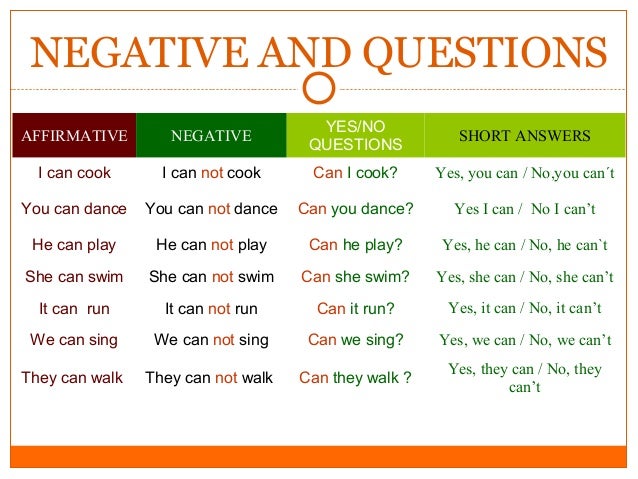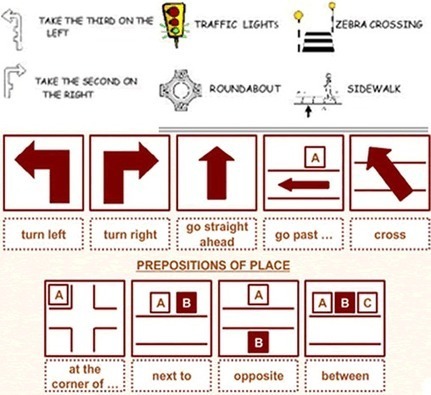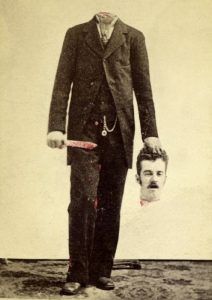Charles Island, near Milford, Connecticut, was dug into one night by a company from that town that had learned of Kidd’s visit to it — and what could Kidd be doing ashore unless he was burying money? The lid of an iron chest had been uncovered when the figure of a headless man came bounding out of the air, and the work was discontinued right then. The figure leaped into the pit that had been dug, and blue flames poured out of it. When the diggers returned, their spades and picks were gone and the ground was smooth.
Monhegan Island, off the
Maine coast, contains a cave, opening to the sea, where it was whispered that treasure had been stored in care of spirits. Searchers found within it a heavy chest, which they were about to lift when one of the party — contrary to orders — spoke. The spell was broken, for the watchful spirits heard and snatched away the treasure. Some years ago the cave was enlarged by blasting, in a hope of finding that chest, for an old saying had been handed down among the people of the island — from whom it came they have forgotten — that was to this effect: “Dig six feet and you will find iron; dig six more and you will find money.”
On Damariscotta Island, near Kennebec, Maine, is a lake of salt water, which, like dozens of shallow ones in this country, is locally reputed to be bottomless. Yet Kidd was believed to have sunk some of his valuables there, and to have guarded against the entrance of boats by means of a chain hung from rock to rock at the narrow entrance, bolts on either side showing the points of attachment, while ring bolts were thought to have been driven for the purpose of tying buoys, thus marking the spots where the chests went down. This island, too, has been held in fear as haunted ground.
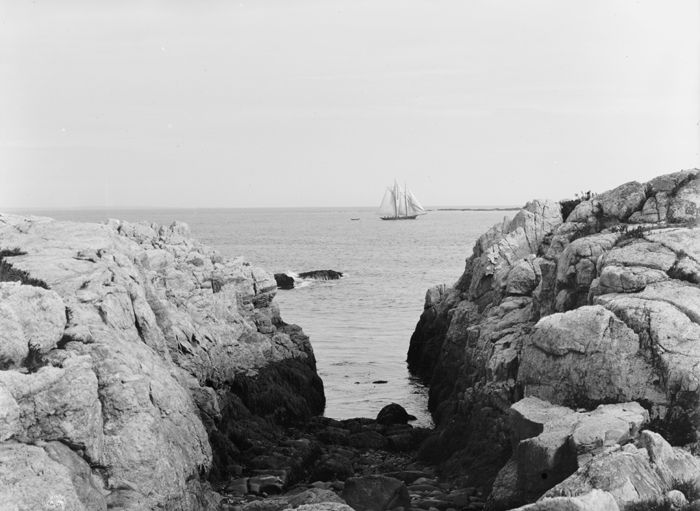
Gorge at Appledore, Isles of Shoals, Maine by Detroit Publishing, 1900
Appledore, in the Isles of Shoals in Maine, was another such a hiding-place, and Kidd put one of his crew to death that he might haunt the place and frighten searchers from their quest. For years no fisherman could be induced to land there after nightfall because an islander once encountered “Old Bab” on his rounds, with a red ring around his neck, a frock hanging about him, phosphorescence gleaming from his body, who peered at the intruder with a white and dreadful face, and nearly scared him to death.
A spot near the Piscataqua River, which defines the border between Maine and
New Hampshire, was another hiding-place, and early in the 19th century the ground was dug over, two of the seekers plying pick and spade, while another stood within the circle they had drawn about the spot and loudly read the Bible. Presently their implements clicked on an iron chest, but it slid sideways into the ground as they tried to uncover it, and at last, an interruption occurred that caused them to stop work so long that when they went to look for it again it had entirely disappeared. This diversion was the appearance of a monster horse that flew toward them from a distance without a sound, but stopped short at the circle where the process of banning fiends was still going on, and, after grazing and walking around them for a time, it dissolved into air.
Kidd’s plug is a part of the craggy steep known as Cro’ Nest, on the Hudson River. It is a projecting knob, like a bung closing an orifice, which is believed to conceal a cavern where the redoubtable captain placed a few barrels of his wealth. Though it is 200 feet up the cliff, inaccessible either from above or below, and weighs many tons, still, as pirates and devils have always been friendly, it may be that the corking of the cave was accomplished with supernatural help, and that if blasts or prayers ever shake the stone from its place a shower of doubloons and diamonds may come rattling after it.
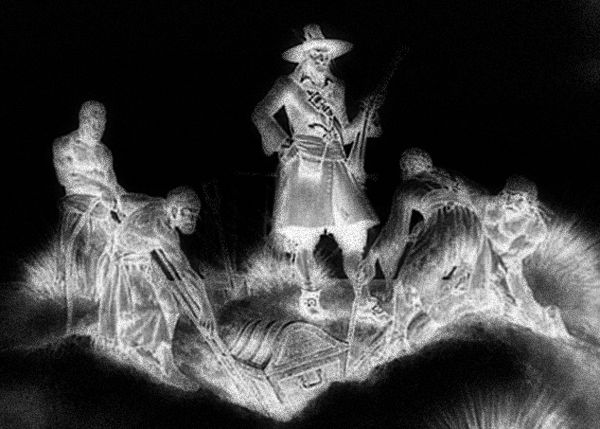
Ghosts guarding treasure
The Rock Hill estate in Medford,
Massachusetts, was plagued by a specter that some thought to be that of a
New Hampshire farmer who was robbed and murdered there, but others say it is the shade of Kidd, for iron treasure chests were found in the cellar that behaved like that on the Piscataqua River, sinking out of sight whenever they were touched by shovels.
Misery Islands, near
Salem, Massachusetts, were dug over, and under spiritual guidance, too, for other installments of Mr. Kidd’s acquisitions, but without avail.
It takes no less than half a dozen
ghosts to guard what is hidden in Money Hill, on Shark River,
New Jersey, so there must be a good deal of it. Some of these guardians are in sailor togs, some in their moldy bones, some peaceable, some noisy with threats and screams and groans — a “rum lot,” as an ancient mariner remarked, who lives near their graves and daytime hiding-places. Many heirlooms are owned by Jerseymen hereabout that were received from Kidd’s sailors in exchange for apple-jack and provisions, and two sailor-looking men are alleged to have taken a strong-box out of Money Hill some years ago, from which they abstracted two bags of gold. After that event, the hill was dug over with great earnestness, but without result to the prospectors other than the cultivation of their patience.
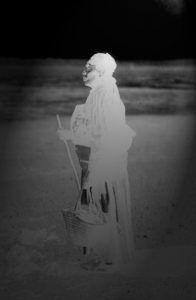
Old Indian Woman Ghost
Sandy Hook, New Jersey, near “Kidd’s tree,” and the clay banks of the Atlantic highlands back of that point, are suspected hiding-places; but the cairn or knoll called Old Woman’s Hill, at the Highlands, is not haunted by Kidd’s men, as used to be said, but by the spirit of a discontented
Indian woman. This spirit, the Indians themselves drove away with stones.
At Oyster Point,
Maryland lived Paddy Dabney, who recognized Kidd from an old portrait on meeting him one evening in 1836. He was going home late from the tavern when a light in a pine thicket caused him to turn from the road. In a clearing among the trees, pervaded by a pale shine which seemed to emanate from its occupants, a strange company was playing at bowls. A fierce-looking reprobate who was superintending the game glanced up, and, seeing Paddy’s pale face, gave such a leap in his direction that the Irishman fled with a howl of terror and never stopped till he reached his door, when, on turning about, he found that the phantom of the pirate chief had vanished. The others, he conceived, were devils, for many a sea rover had sold himself to Satan. Captain Teach, or
Blackbeard, proved as much to his crew by shutting himself in the hold of his ship, where he was burning sulphur to destroy rats, and withstanding suffocation for several hours; while one day a dark man appeared on board who was not one of the crew at the sailing, and who had gone as mysteriously as he came on the day before the ship was wrecked. It was known that Kidd had buried his Bible in order to ingratiate the evil one.
A flat rock on the north shore of Liberty Island, in New York harbor, was also thought to mark the place of this pervasive wealth of the pirates. As late as 1830, Sergeant Gibbs, one of the garrison at the island, tried to unearth it, with the aid of a fortune-teller and a recruit, but they had no sooner reached a box about four feet in length than a being with wings, horns, tail, and a breath, the latter palpable in blue flames, burst from the coffer. Gibbs fell unconscious into the water and narrowly escaped drowning, while his companions ran away, and the treasure may still be there for aught we know.
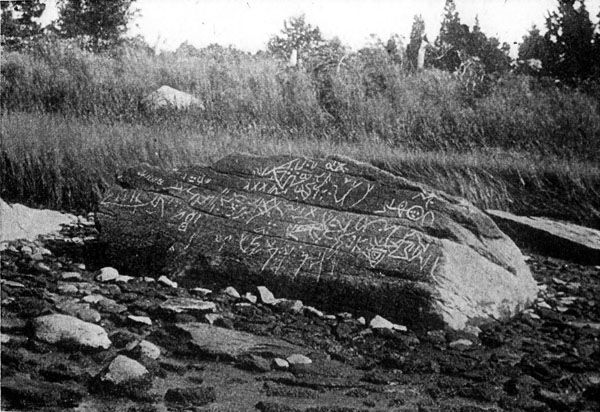
Dighton Rock, Massachusetts
The shore for several hundred feet around
Dighton Rock,
Massachusetts, has been examined, for it was once believed that the inscriptions on it were cut by Kidd to mark the place of burial for part of his hoard.
Back in the days before the
American Revolution, a black man called Mud Sam, who lived in a cabin at the Battery of New York City, was benighted at about the place where 100th Street now touches East River while waiting there for the tide to take him up the Sound. He beguiled the time by a nap, and, on waking, he started to leave his sleeping place under the trees to regain his boat, when the gleam of a lantern and the sound of voices coming up the bank caused him to shrink back into the shadow. At first he thought that he might be dreaming, for Hell Gate was a place of such repute that one might readily have bad dreams there, and the legends of the spot passed quickly through his mind: the skeletons that lived in the wreck on Hen and Chickens and looked out at passing ships with blue lights in the eye-sockets of their skulls; the brown fellow, known as “the pirate’s spuke,” that used to cruise up and down the wrathful torrent, and was snuffed out of sight for some hours by old Peter Stuyvesant with a silver bullet; a black-looking scoundrel with a split lip, who used to brattle about the tavern at Corlaer’s Hook, and who tumbled into East River while trying to lug an iron chest aboard of a suspicious craft that had stolen in to shore in a fog. This latter body was often seen riding up Hell Gate a-straddle of that very chest, snapping his fingers at the stars and roaring Bacchanalian odes, just as skipper Onderdonk’s boatswain, who had been buried at sea without prayers, chased the ship for days, sitting on the waves, with his shroud for a sail, and shoving hills of water after the vessel with the plash of his hands.
These gruesome memories sent a quake through Mud Sam’s heart, but when the bushes cracked under the strangers’ tread, he knew that they were of flesh and bone, and, following them for a quarter-mile into the wood, he saw them dig a hole, plant a strong-box there, and cover it. A threatening remark from one of the company forced an exclamation from the negro that drew a pistol-shot upon him, and he took to his heels. Such a fright did he receive that he could not for several years be persuaded to return, but when that persuasion came in the form of a promise of wealth from Wolfert Webber, a cabbage-grower of the town, and promises of protection from Dr. Knipperhausen, who was skilled in incantations, he was not proof against it, and guided the seekers to the spot.
After the doctor had performed the proper ceremonies they fell to work, but no sooner had their spades touched the lid of an iron-bound chest than a sturdy rogue with a red flannel cap leaped out of the bushes. They said afterward that he had the face of the brawler who was drowned at Corlaer’s Hook, but, in truth, they hardly looked at him in their flight; nor, when the place was revisited, could any mark of digging be found, nor any trace of treasure, so that part of Kidd’s wealth may be at this moment snugly stowed in the cellar of a tenement. Webber had engaged in so many crazy enterprises of this nature that he had neglected cabbage culture, and had grown so poor that the last disappointment nearly broke his heart. He retired to his chamber and made his will, but on learning that a new street had been run across his farm and that it would presently be worth ten times as much for building-lots as it ever had been for cabbages, he leaped out of bed, dressed himself, and prospered for many a day after.










